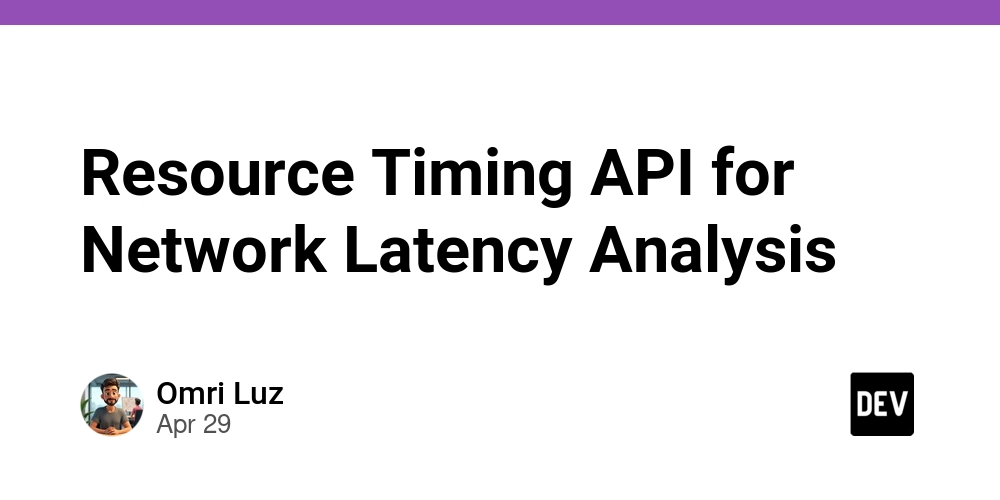Resource Timing API for Network Latency Analysis
Resource Timing API for Network Latency Analysis: An In-Depth Exploration The Resource Timing API is a powerful feature of the modern web that provides insights into network performance metrics related to resource loading. It plays a critical role in network latency analysis — one of the most significant factors influencing the user experience on the web. This article aims to provide an exhaustive and nuanced exploration of the Resource Timing API, its historical context, practical applications, performance considerations, and advanced implementation techniques designed for seasoned developers. Historical Context Before the introduction of the Resource Timing API with the W3C specification in 2012, developers relied heavily on rudimentary techniques like window.performance and other developer tools to measure network performance. The need for a dedicated set of interfaces stemmed from the increasing usage of front-end frameworks, single-page applications (SPAs), and a general push for enhanced site performance and metrics benchmarking. Historically, JavaScript developers faced several challenges, such as limited access to detailed network statistics and the overhead of relying on third-party analytics tools. The Resource Timing API emerged as a response to these challenges, enabling developers to gather high-resolution data about the timing of various HTTP resources with a focus on their load durations. Overview of the Resource Timing API The Resource Timing API allows developers to capture detailed timing information from the ResourceLoading phase through to the fetch phase. When a web application loads resources, they might experience different timings in several phases, such as DNS resolution, connection establishment, and data transfer. The Resource Timing API gathers this data into easily understandable objects. if (window.performance && window.performance.getEntriesByType) { const resources = performance.getEntriesByType("resource"); console.log(resources); } The performance.getEntriesByType("resource") method returns an array of PerformanceResourceTiming objects that detail the timings of resources fetched by the document. Key Properties of PerformanceResourceTiming Before diving deeper into the implementation, it is crucial to understand the properties of PerformanceResourceTiming: connectEnd: The timestamp when the browser finished establishing a connection to the server. connectStart: The time the browser starts establishing a connection. domComplete: The time when the document has completely loaded and parsed. domContentLoadedEventEnd: The time when the DOMContentLoaded event is completed. fetchStart: The point when the request was initiated. responseEnd: The time when the response data is received. redirectEnd: The point when following a redirect ends. By examining these timestamps, developers can identify bottlenecks and optimize resource loading sequences. Complex Code Examples and Advanced Implementation Techniques Code Example 1: Analyzing Network Latency for Multiple Resources In this example, we will collect resource loading metrics for multiple resources and analyze their network latencies. document.addEventListener("load", function() { if (window.performance && window.performance.getEntriesByType) { const resources = performance.getEntriesByType("resource"); resources.forEach(resource => { const performanceData = { name: resource.name, fetchStart: resource.fetchStart, responseEnd: resource.responseEnd, duration: resource.responseEnd - resource.fetchStart, connectTime: resource.connectEnd - resource.connectStart, redirectTime: resource.redirectEnd - resource.redirectStart, }; console.log(performanceData); }); } }, true); Code Example 2: Creating a Visualization of Resource Loading Times This example demonstrates how to aggregate resource loading metrics and visualize them using a library like Chart.js. document.addEventListener("load", function() { const resources = performance.getEntriesByType("resource"); const resourceData = resources.map(resource => ({ name: resource.name, latency: resource.responseEnd - resource.fetchStart })); const data = { labels: resourceData.map(res => res.name), datasets: [{ label: 'Resource Latency (ms)', data: resourceData.map(res => res.latency), backgroundColor: 'rgba(75, 192, 192, 0.2)', borderColor: 'rgba(75, 192, 192, 1)', borderWidth: 1 }] }; const ctx = document.getElementById('myChart').getContext('2d'); new Chart(ctx, { type: 'bar', data: data, options: { scales: { y: {

Resource Timing API for Network Latency Analysis: An In-Depth Exploration
The Resource Timing API is a powerful feature of the modern web that provides insights into network performance metrics related to resource loading. It plays a critical role in network latency analysis — one of the most significant factors influencing the user experience on the web. This article aims to provide an exhaustive and nuanced exploration of the Resource Timing API, its historical context, practical applications, performance considerations, and advanced implementation techniques designed for seasoned developers.
Historical Context
Before the introduction of the Resource Timing API with the W3C specification in 2012, developers relied heavily on rudimentary techniques like window.performance and other developer tools to measure network performance. The need for a dedicated set of interfaces stemmed from the increasing usage of front-end frameworks, single-page applications (SPAs), and a general push for enhanced site performance and metrics benchmarking.
Historically, JavaScript developers faced several challenges, such as limited access to detailed network statistics and the overhead of relying on third-party analytics tools. The Resource Timing API emerged as a response to these challenges, enabling developers to gather high-resolution data about the timing of various HTTP resources with a focus on their load durations.
Overview of the Resource Timing API
The Resource Timing API allows developers to capture detailed timing information from the ResourceLoading phase through to the fetch phase. When a web application loads resources, they might experience different timings in several phases, such as DNS resolution, connection establishment, and data transfer. The Resource Timing API gathers this data into easily understandable objects.
if (window.performance && window.performance.getEntriesByType) {
const resources = performance.getEntriesByType("resource");
console.log(resources);
}
The performance.getEntriesByType("resource") method returns an array of PerformanceResourceTiming objects that detail the timings of resources fetched by the document.
Key Properties of PerformanceResourceTiming
Before diving deeper into the implementation, it is crucial to understand the properties of PerformanceResourceTiming:
- connectEnd: The timestamp when the browser finished establishing a connection to the server.
- connectStart: The time the browser starts establishing a connection.
- domComplete: The time when the document has completely loaded and parsed.
- domContentLoadedEventEnd: The time when the DOMContentLoaded event is completed.
- fetchStart: The point when the request was initiated.
- responseEnd: The time when the response data is received.
- redirectEnd: The point when following a redirect ends.
By examining these timestamps, developers can identify bottlenecks and optimize resource loading sequences.
Complex Code Examples and Advanced Implementation Techniques
Code Example 1: Analyzing Network Latency for Multiple Resources
In this example, we will collect resource loading metrics for multiple resources and analyze their network latencies.
document.addEventListener("load", function() {
if (window.performance && window.performance.getEntriesByType) {
const resources = performance.getEntriesByType("resource");
resources.forEach(resource => {
const performanceData = {
name: resource.name,
fetchStart: resource.fetchStart,
responseEnd: resource.responseEnd,
duration: resource.responseEnd - resource.fetchStart,
connectTime: resource.connectEnd - resource.connectStart,
redirectTime: resource.redirectEnd - resource.redirectStart,
};
console.log(performanceData);
});
}
}, true);
Code Example 2: Creating a Visualization of Resource Loading Times
This example demonstrates how to aggregate resource loading metrics and visualize them using a library like Chart.js.
document.addEventListener("load", function() {
const resources = performance.getEntriesByType("resource");
const resourceData = resources.map(resource => ({
name: resource.name,
latency: resource.responseEnd - resource.fetchStart
}));
const data = {
labels: resourceData.map(res => res.name),
datasets: [{
label: 'Resource Latency (ms)',
data: resourceData.map(res => res.latency),
backgroundColor: 'rgba(75, 192, 192, 0.2)',
borderColor: 'rgba(75, 192, 192, 1)',
borderWidth: 1
}]
};
const ctx = document.getElementById('myChart').getContext('2d');
new Chart(ctx, {
type: 'bar',
data: data,
options: {
scales: {
y: {
beginAtZero: true
}
}
}
});
});
Performance Considerations and Optimization Strategies
1. Critical Resource Loading
Focus on optimizing the loading of critical resources, such as CSS and JavaScript files. Assess the times captured from Resource Timing API and consider using techniques like preload for essential resources.
rel="preload" href="/styles/main.css" as="style">
2. Minimizing Resource Size
Consider leveraging tools like Webpack and Gzip for reducing resource sizes, thereby improving the response time measured by the Resource Timing API.
3. Asynchronous Loading
Utilize asynchronous loading techniques for non-critical scripts. Load scripts with the async or defer attributes to prevent blocking rendering and to optimize resource fetch times.
Real-World Use Cases
1. E-Commerce Websites
In high-traffic e-commerce applications, understanding the load times of product images or scripts can significantly improve conversion rates. Utilizing the Resource Timing API, developers can focus on optimizing the loading of critical product data and images.
2. Progressive Web Apps (PWAs)
PWAs require efficient resource loading to ensure a seamless offline experience. The Resource Timing API can help pinpoint which resources are slowing down load times when the user is offline.
Potential Pitfalls and Advanced Debugging Techniques
Pitfalls
Cross-Origin Load Issues: Resources loaded from a different origin may not be fully captured due to the Same-Origin Policy. Be vigilant about your server’s CORS configurations.
Mono-threading in JavaScript: Heavy computations can impact the timing measurements as JavaScript is single-threaded. Profiling tools should be integrated to avoid these issues.
Debugging Techniques
Use browser developer tools to visualize the Timeline view and correlate it with the data collected using the Resource Timing API.
Log specific performance marks and metrics to diagnose issues in different environments, e.g., staging vs. production.
console.log(JSON.stringify(performance.getEntriesByType("resource")));
Comparison with Alternative Approaches
1. Navigation Timing API
Unlike the Resource Timing API, which provides granular detail on resource loads, the Navigation Timing API gives broader insights about the overall page load process. Combining the two can yield a comprehensive view of both resource and navigation performance.
2. Long Tasks API
The Long Tasks API can help identify tasks in the main thread that block user interactions. This API can be a complementary tool to the Resource Timing API as it reveals the impact of heavy scripts on resource loading.
Advanced Resources for Further Reading
- W3C Resource Timing Specification
- MDN Web Docs - Resource Timing API
- Google Web Fundamentals - Measuring Performance
Conclusion
The Resource Timing API presents an invaluable tool for developers aiming to analyze and improve the performance of their web applications. The ability to gain insights into resource-loading timings allows for informed decisions on optimization strategies, ultimately leading to an enhanced user experience.
As web technologies continue to evolve, understanding the technicalities of APIs like Resource Timing becomes increasingly important. The insights derived from detailed analysis, alongside strategic optimization, will ensure the web remains a fast and responsive medium, meeting the demands of users in a complex digital landscape.
Incorporating the Resource Timing API effectively can lead to the next generation of optimized web applications, ready to withstand the performance-centric goals of the industry.





































































































































































![[The AI Show Episode 145]: OpenAI Releases o3 and o4-mini, AI Is Causing “Quiet Layoffs,” Executive Order on Youth AI Education & GPT-4o’s Controversial Update](https://www.marketingaiinstitute.com/hubfs/ep%20145%20cover.png)







































































































































































































































































_NicoElNino_Alamy.jpg?width=1280&auto=webp&quality=80&disable=upscale#)





























































































![Craft adds Readwise integration for working with book notes and highlights [50% off]](https://i0.wp.com/9to5mac.com/wp-content/uploads/sites/6/2025/04/craft3.jpg.png?resize=1200%2C628&quality=82&strip=all&ssl=1)















![Apple Restructures Global Affairs and Apple Music Teams [Report]](https://www.iclarified.com/images/news/97162/97162/97162-640.jpg)
![New iPhone Factory Goes Live in India, Another Just Days Away [Report]](https://www.iclarified.com/images/news/97165/97165/97165-640.jpg)




































































































